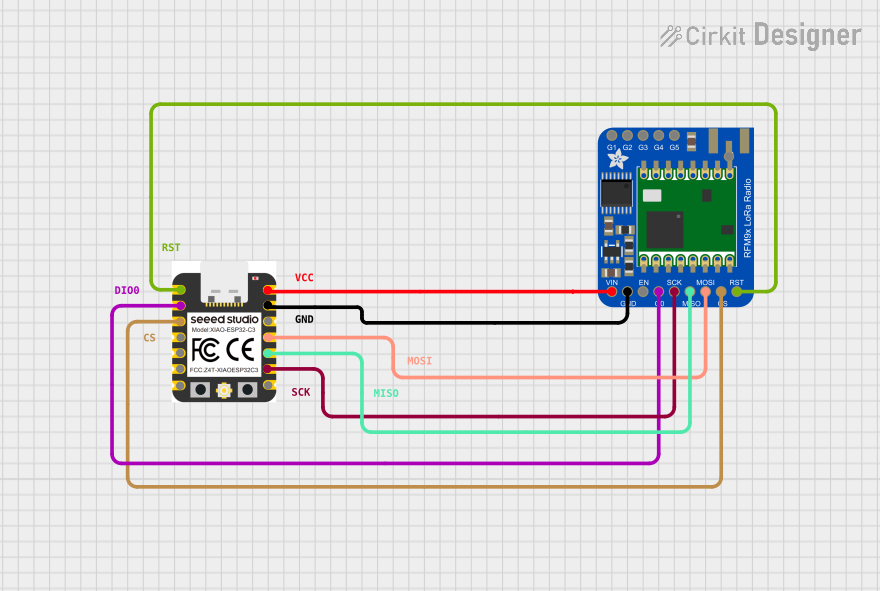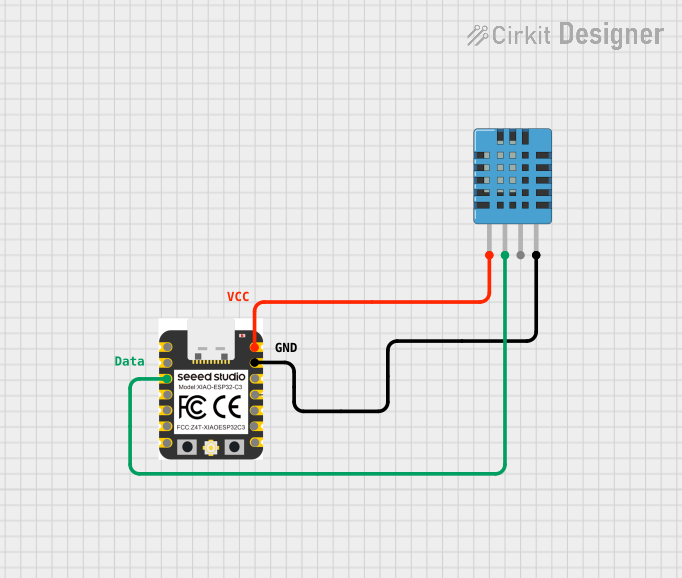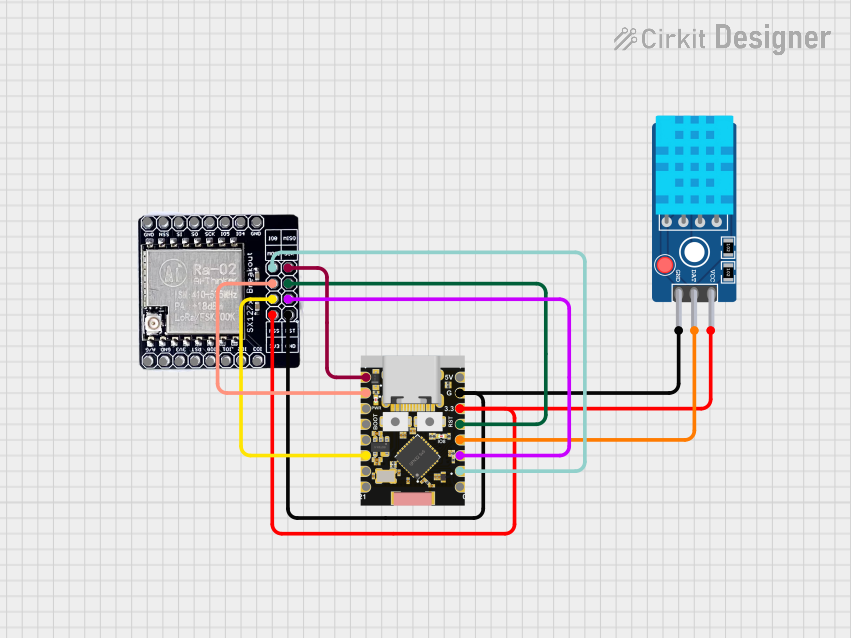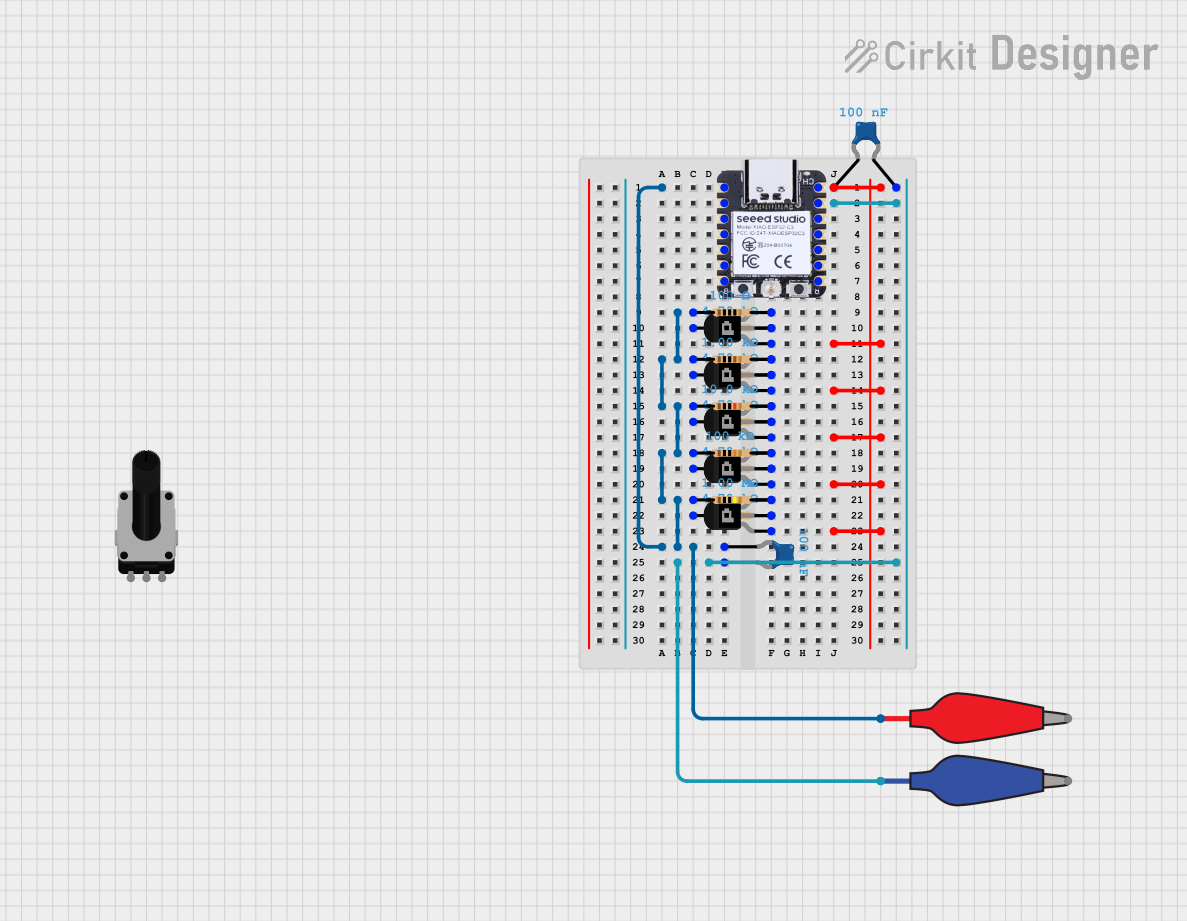
How to Use XIAO ESP32C3: Examples, Pinouts, and Specs
 Design with XIAO ESP32C3 in Cirkit Designer
Design with XIAO ESP32C3 in Cirkit DesignerIntroduction
The XIAO ESP32C3 is a highly integrated, low-power development board produced by Seeed Studio, designed for Internet of Things (IoT) applications and embedded systems development. Based on the ESP32-C3 microcontroller from Espressif Systems, this board offers Wi-Fi connectivity, a rich set of peripherals, and a compact form factor, making it ideal for space-constrained projects.
Explore Projects Built with XIAO ESP32C3

 Open Project in Cirkit Designer
Open Project in Cirkit Designer
 Open Project in Cirkit Designer
Open Project in Cirkit Designer
 Open Project in Cirkit Designer
Open Project in Cirkit Designer
 Open Project in Cirkit Designer
Open Project in Cirkit DesignerExplore Projects Built with XIAO ESP32C3

 Open Project in Cirkit Designer
Open Project in Cirkit Designer
 Open Project in Cirkit Designer
Open Project in Cirkit Designer
 Open Project in Cirkit Designer
Open Project in Cirkit Designer
 Open Project in Cirkit Designer
Open Project in Cirkit DesignerCommon Applications and Use Cases
- Smart home devices
- Wireless sensors and actuators
- IoT nodes
- Wearable electronics
- Prototyping for embedded systems
Technical Specifications
Key Technical Details
- Microcontroller: ESP32-C3
- Operating Voltage: 3.3V
- Input Voltage (recommended): 5V via USB-C or battery
- Digital I/O Pins: 11
- Analog Input Pins: 4
- Flash Memory: 4MB
- SRAM: 400 KB
- CPU Frequency: up to 160 MHz
- Wi-Fi: 802.11 b/g/n (2.4 GHz)
- Bluetooth: BLE 5.0
- Interface: USB-C
Pin Configuration and Descriptions
| Pin Number | Function | Description |
|---|---|---|
| 1 | 3V3 | 3.3V power supply |
| 2 | GND | Ground |
| 3 | ADC/DAC/GPIO | Analog-to-Digital Converter/Digital-to-Analog Converter/General Purpose I/O |
| ... | ... | ... |
| n | GPIO | General Purpose I/O |
Note: The full pinout diagram and detailed descriptions can be found in the official datasheet provided by Seeed Studio.
Usage Instructions
How to Use the Component in a Circuit
Powering the Board:
- Connect the USB-C cable to the board and a 5V USB power source.
- Alternatively, connect a battery to the designated pins, ensuring correct polarity.
Connecting to Wi-Fi:
- Utilize the onboard Wi-Fi capabilities to connect to a network for IoT applications.
Programming the Board:
- The XIAO ESP32C3 can be programmed using the Arduino IDE or other compatible development environments.
- Select the appropriate board and port in your IDE before uploading your code.
Important Considerations and Best Practices
- Always ensure that the input voltage does not exceed the recommended levels to prevent damage.
- When designing circuits, consider the current limitations of the GPIO pins.
- Use proper decoupling capacitors close to the power pins to minimize power supply noise.
- For Wi-Fi and Bluetooth applications, ensure that the antenna area is not obstructed to maintain signal integrity.
Troubleshooting and FAQs
Common Issues Users Might Face
Board not recognized by the computer:
- Check the USB cable and connections.
- Ensure that the correct drivers are installed.
Wi-Fi connectivity issues:
- Verify the network credentials and signal strength.
- Check for sources of Wi-Fi interference.
Programming errors:
- Ensure that the correct board and port are selected in the IDE.
- Check the code for syntax and logical errors.
Solutions and Tips for Troubleshooting
- If the board is not recognized, try using a different USB port or cable.
- For Wi-Fi issues, try restarting the router and the board to re-establish the connection.
- When encountering programming errors, refer to the error messages in the IDE for clues on how to resolve them.
Example Code for Arduino UNO
#include <WiFi.h>
// Replace with your network credentials
const char* ssid = "your_SSID";
const char* password = "your_PASSWORD";
void setup() {
Serial.begin(115200);
// Connect to Wi-Fi
WiFi.begin(ssid, password);
while (WiFi.status() != WL_CONNECTED) {
delay(1000);
Serial.println("Connecting to WiFi...");
}
Serial.println("Connected to WiFi");
}
void loop() {
// Your code here
}
Note: This example demonstrates how to connect the XIAO ESP32C3 to a Wi-Fi network. Ensure that you replace your_SSID and your_PASSWORD with your actual Wi-Fi credentials.
For more detailed information, refer to the Seeed Studio Wiki and the Espressif ESP32-C3 Documentation.